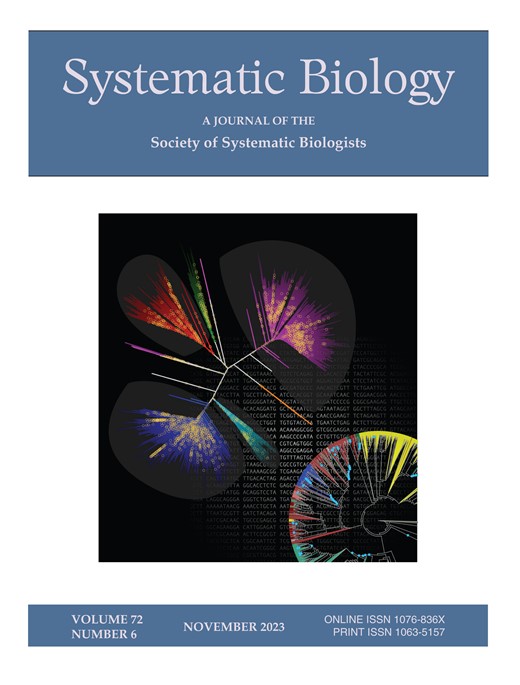Rampant Reticulation in a Rapid Radiation of Tropical Trees -Insights from Inga (Fabaceae)
IF 5.7
1区 生物学
Q1 EVOLUTIONARY BIOLOGY
引用次数: 0
Abstract
Evolutionary radiations underlie much of the species diversity of life on Earth, particularly within the world’s most species-rich tree flora – that of the Amazon rainforest. Hybridisation occurs in many radiations, with effects ranging from homogenisation of divergent species to the generation of genetic and phenotypic novelty that fuels speciation. However, the influence of hybridisation on Amazonian tree radiations has been little studied. We address this using the ubiquitous, species-rich, neotropical tree genus Inga, which typifies rapid radiations of rainforest trees. We assess patterns of gene tree incongruence to ascertain whether hybridisation was associated with rapid radiation in Inga. Given the importance of insect herbivory in structuring rainforest tree communities (and hence the potential for hybridisation to promote adaptation through admixture of defence traits), we also test whether introgression of loci underlying chemical defences against herbivory occurred during the radiation of Inga. Our phylogenomic analyses of 189/288 Inga species using >1300 target capture loci showed widespread introgression in Inga. Specifically, we found widespread phylogenetic incongruence explained by introgression, with phylogenetic networks recovering multiple introgression events across Inga and up to 20% of shared, likely introgressed, genetic variation between some species. In addition, most defence chemistry loci showed evidence of positive selection and marginally higher levels of introgression. Overall, our results suggest that introgression has occurred widely over the course of Inga’s history, possibly in a syngameon scenario, likely facilitated by extensive dispersal across Amazonia. Furthermore, in some cases introgression of chemical defence loci may influence adaptation in Inga.热带树木快速辐射中的猖獗网状——来自印加科的启示
进化辐射是地球上许多物种多样性的基础,特别是在世界上物种最丰富的树木植物群——亚马逊雨林中。杂交发生在许多辐射中,其影响范围从不同物种的同质化到产生促进物种形成的遗传和表型新颖性。然而,杂交对亚马逊树木辐射的影响研究甚少。我们使用无所不在的、物种丰富的新热带树种因加来解决这个问题,它是热带雨林树木快速辐射的典型。我们评估基因树不一致的模式,以确定杂交是否与因加的快速辐射有关。考虑到昆虫食草性在构建雨林树木群落中的重要性(因此可能通过杂交来促进防御性状的混合适应),我们还测试了因加辐射期间是否发生了针对食草性化学防御的基因座渗入。我们利用&;gt;1300个目标捕获位点对189/288个印加物种进行了系统基因组分析,结果显示印加物种存在广泛的基因渗入。具体来说,我们发现广泛存在的系统发育不一致可以用基因渗入来解释,系统发育网络恢复了英加的多个基因渗入事件,以及一些物种之间多达20%的可能基因渗入的共享遗传变异。此外,大多数防御化学位点显示出正选择和略高水平的渗入的证据。总的来说,我们的研究结果表明,在英加的历史过程中,基因渗入已经广泛发生,可能是在一个合成子情景中,可能是由于在亚马逊地区的广泛分散而促进的。此外,在某些情况下,化学防御位点的渗入可能影响印加的适应。
本文章由计算机程序翻译,如有差异,请以英文原文为准。
求助全文
约1分钟内获得全文
求助全文
来源期刊

Systematic Biology
生物-进化生物学
CiteScore
13.00
自引率
7.70%
发文量
70
审稿时长
6-12 weeks
期刊介绍:
Systematic Biology is the bimonthly journal of the Society of Systematic Biologists. Papers for the journal are original contributions to the theory, principles, and methods of systematics as well as phylogeny, evolution, morphology, biogeography, paleontology, genetics, and the classification of all living things. A Points of View section offers a forum for discussion, while book reviews and announcements of general interest are also featured.
 求助内容:
求助内容: 应助结果提醒方式:
应助结果提醒方式:


